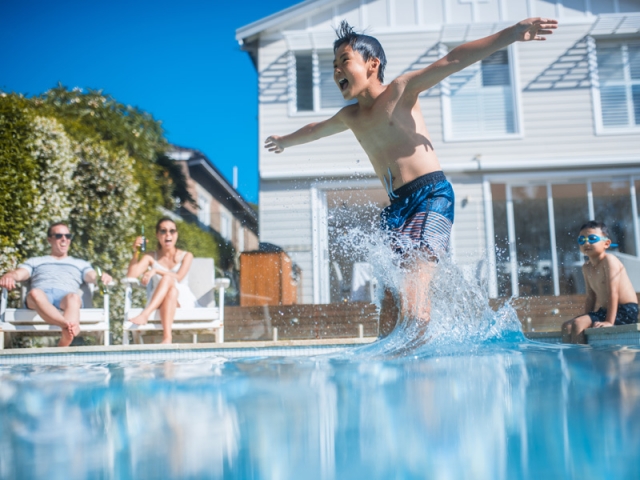Swimming pool: pro tips for safe swimming © iStock
Having a swimming pool is the dream of many French people. In summer – but also in winter, when it is covered – it is a source of pleasure for young and old alike. But the swimming pool has also become an asset in improving the value of one’s property. Houses with a beautiful, well-maintained pool are all the more attractive to potential buyers.
Once you have chosen the filtration system, the water treatment, and the surroundings of the pool, you will need to opt for a security system. Securing your pool is indeed mandatory, and you could be held responsible in the event of an accident. Many devices and arrangements exist to ensure maximum safety.
However, “protection systems cannot replace the supervision of a designated adult”, insists the Federation of swimming pool professionals (FPP). A few seconds of inattention, and a child can drown, even in an area where he has foot. Vigilance is therefore required, even if “90% of drownings take place in a water point other than the swimming pool”, and that the family pool remains the ideal place to learn to swim.
To spend a quiet summer while enjoying the pleasure of a water basin, the FPP offers some crucial advice.
Adult vigilance for safe swimming
All the safety equipment in the world cannot replace the vigilance of an adult – not another child or adolescent – to supervise children who bathe in a private swimming pool. In short, this is the main advice for all pool professionals.
Indeed, “the majority of accidents occur in the absence of vigilance and, for about half, at the time of swimming, that is to say when all the safety systems are crossed or deactivated”, analyzes the FPP in a press release.
A designated and vigilant adult
It is therefore necessary to explicitly designate a person (or more) responsible for the surveillance of swimmers. “If no adult has been clearly designated, each thinks that the other is watching”, rightly underlines the FPP.
“The adult in charge of monitoring the child can and must monitor the entire surface of the water in this small space., continues the federation. He must stay in active vigilance : do not go on the phone or speak with other people while monitoring. “
The right actions to avoid swimming accidents
Being vigilant is essential, being well prepared is even better. A swimming accident can happen so quickly, especially if it involves young children, that the reaction time must be very short.
It is therefore better to keep the emergency equipment : a pole and a buoy … but also a telephone to alert the emergency services quickly if necessary (dial 18 or 112). Get trained in life saving skills, for example with the Red Cross, to know how to react quickly and effectively in the event of drowning.
Equip children and educate them
To protect the little ones, often the first victims of swimming accidents, “equip them with armbands or a swimsuit with floats as soon as they are near the swimming pool”, advises the FPP, which adds that “the buoy is insufficient equipment for small children who do not know how to use it”.
The federation also recalls the crucial role of parents, who must educate their children, from an early age, to the dangers of water, and to accompany them quickly in learning to swim.
After swimming, “take out floating objects (toys, buoys, inflatable objects) and put the safety device back in place”, conclude the professionals.
Safety systems to prevent accidental falls
Solutions to secure your pool © Thinkstock
He is mandatory to install a standardized safety system for any in-ground or semi-in-ground family swimming pool, according to a law dating from 2003. To do this, you have the choice between four solutions:
- The barrier (NF P 90 306 standard): installed around the swimming pool, it regulates access. Impossible for the little ones to get to the water’s edge without an adult opening the door for them. At the same time, accidental falls of older children in the pool are avoided, especially at night.
- Security blanket (standard NF P 90 308): there are many models, from stretched tarpaulins to rigid covers, automated or not, including the very ingenious (but expensive) system of movable bottom swimming pools. It completely closes the pool, and thus prevents any access to water, while protecting the pool from dirt.
- Shelter (NF P 90 309 standard): here again, many models exist, telescopic, motorized or not. Low, it also protects the pool from impurities. High, it allows you to bathe in all weathers. In both cases, it forms a transparent and effective barrier.
- Alarm (standard NF P 90 307-1, in accordance with decree 2009-873 of July 16, 2009 in the case of an immersion alarm): it is triggered in the event of a fall in water. It is then necessary to react extremely quickly, therefore to be present in the direct surroundings of the basin.
- And for above-ground pools only, secure ladder : the ladder securing equipment, shutter, lifting or safe ladder, prevent a child from inadvertently climbing and falling into the water.
“Consumers must choose their system according to their needs: family composition, shape of the pool, use, situation in primary or secondary residence, insists the FPP, and request a certificate of conformity from the laboratory to the supplier “.
Corn this equipment, as essential as it is, should not replace increased vigilance. “Their installation must not lead to disempowering the consumer”, conclude the professionals, especially since they are only effective if they are correctly used, re-engaged or closed after swimming, and well maintained.



